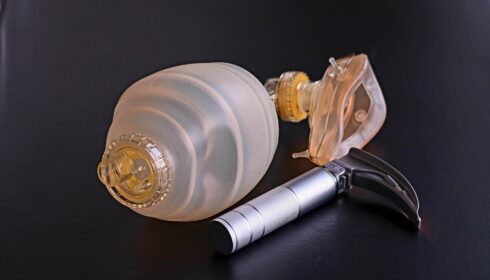OPERA

Effect of early post extubation high-flow nasal cannula vs conventional oxygen therapy on hypoxemia in patients after major abdominal surgery: a French multi centre randomised controlled trial (OPERA)
Samir Jaber. Intensive Care Med(2016) 42:1888-1898
Clinical Question
- In patients who have undergone major abdominal surgery does the application of high flow nasal cannulae compared with standard oxygen therapy, decrease the incidence of hypoxemia at one hour after extubation?
Design
- Randomised clinical trial
- Multicentre
- Patients were pre-consented before surgery
- 1:1 randomisation with a computer-generated assignment sequence
- Stratification by study centre and the intended use of postoperative epidural analgesia
- Modified (excluded 8 patients: 3 had because surgery was cut short due to extensive illness and 5 who had exclusion criteria) intention to treat analysis (8 more patients added to study to achieve full sample size)
- Sample size calculation made assuming a 40% incidence of hypoxaemia after extubation, with a 90% power to detect a relative difference of 50% in the primary outcome between the 2 groups
- Unadjusted Chi squared test was used for primary outcome analysis
Setting
- Three university hospitals in France
- November 2013 – March 2015
Population
- Inclusion: All adult patients scheduled for planned or unplanned abdominal, or abdominal and thoracic surgery with an anticipated duration of 2 hours or more AND having moderate to high risk of post-operative pulmonary complications (ARISCAT risk score >26 points)
- Exclusion: Life threatening condition requiring emergency surgery, OSA, Pregnancy, BMI >35
- 220 patients
- Baseline characteristics (demographics, comorbidities, type of surgery, duration of surgery, pre-op risk score) were similar in both groups
Intervention
- High Flow Nasal Cannula therapy
- Gas flow 50-60 L/min
- Target SpO2 >95%
Control
- Usual care with standard oxygen therapy
- Oxygen flow titrated to maintain SpO2 >95%
- O2 delivery with continuous nasal prongs or facemask
Both groups
- Treatment stopped on 1st post op day (between 7 – 8AM)
- ABG on room air after 1st hour and at the end of treatment period
- Treatment interrupted if acute respiratory failure requiring immediate intubation or if intolerant of assigned therapy
- Baseline interventions of the groups were similar (usual care vs HFNC)
- Duration of intra-op ventilation 390 vs 377 minutes
- Use of PEEP, recruitment manoeuvres, low tidal volume ventilation
- Fluid administration (4000 vs 3250ml)
- Blood transfusion (12% vs 11%)
Outcome
- Primary outcomes:
- The proportion of patients who developed hypoxaemia (P:F <300) 1 hour after extubation: 24% usual care (27/112) vs 21% HFNC (23/108) P=0.62
- The proportion of patients who developed hypoxaemia (P:F <300) after discontinuation of the study treatment: 30% usual care (34/112) vs 27% HFNC (29/108) P=0.57
- Secondary outcomes: (usual care vs HFNC). No differences
- Need for additional O2 at treatment end (82% vs 73%)
- Pulmonary complications by day 7 (61% vs 54%)
- Hypoxaemia: SpO2 < 92% on >10L/min, PaO2 <60mmHg on room air or PaO2 <80mmHg on supplemental O2 (27% vs 28%)
- Need for intubation or NIV (13% vs 19%)
- Unexpected ICU admission (14% vs 15%)
- ICU LOS days (5 vs 6)
- Hospital LOS days (11 vs 12)
- In hospital mortality (3% vs 2%)
Authors’ Conclusions
- Among patients undergoing major abdominal surgery and receiving intra operative lung protective ventilation, preventive application of HFNC after extubation, compared with standard oxygen therapy, did not result in a statistically significant reduction in the incidence of postoperative hypoxaemia. The routine use of postoperative HFNC after extubation does not seem to be justified in similar patients
Strengths
- Multi centre RCT
- Well matched treatment and control groups
- Primary endpoint of hypoxemia is objective but arguably this is not a clinically meaningful outcome: if the patient is dyspnoeic, needs intubation or NIV these are clinically relevant but a patient with SpO2 of 92% may be asymptomatic
- Allocation concealment
- Follow-up to hospital discharge seems complete
Weaknesses
- Study protocol did not include standardisation for different aspects of patient care (but it’s a pragmatic trial so this probably doesn’t matter)
- Adherence to use of recruitment manoeuvres during surgery was low (but doesn’t impact results as no imbalance)
- Short duration of HFNC post-op – was 16 hours long enough to prevent hypoxic complications, or does the risk extend longer than this?
- Single blinding of statisticians/coordinating centre but patients and staff members collecting data were unblinded.
- The post hoc analysis of the patients that received recruitment manoeuvres is difficult to interpret given the very small numbers that received these.
The Bottom Line
- This is the first trial to evaluate the usefulness of preventive application of HFNC directly after extubation in abdominal surgical patients. The routine use of HFNC therapy is not warranted but it can still be used judiciously in appropropriately monitored settings with experienced staff. The utility of HFNC therapy in high risk patients and when used for longer durations need to be explored
External Links
- [article] Effect of early postextubation high-flow nasal cannula vs conventional oxygen therapy on hypoxaemia in patients after major abdominal surgery: a French multicentre randomised controlled trial (OPERA)
- [further reading] Effect of Postextubation HFNC vs Conventional O2 Therapy on Reintubation in Low-risk Patients. A Randomized Clinical Trial
- [further reading] FLORALI: High-Flow O2 through Nasal Cannula in Acute Hypoxemic Respiratory Failure
Metadata
Summary author: Ravindra Pochiraju and Adrian Clarke
Summary date: 1st March 2017
Peer-review editor: Celia Bradford




Thank you Adrian and your Journal Club team. This is an excellent summary of an interesting #periopmed trial.
I agree that the trial was well conducted and the conclusion is probably valid and generalisable. The secondary outcomes highlight some points of interest to me… this is a group of patients with 3% mortality (arguably “moderate” risk of peri-op death) but look at the incidence rate for pulmonary complications, need for intubation or NIV and unexpected ICU admissions. They’re higher than we should be tolerating, and that’s inside a trial. I suspect real-world data would be similar or worse. More treatment theories, hypotheses and trials are needed urgently to improve peri-operative care in these patients.
Thank you for these fine reviews on CC publications.
To me, this one has a rather odd primary endpoint being “incidence of hypoxemia at one hour after extubation”. If the results would be positive it is unclear what this actually means for the patient in the long run.
Best regards